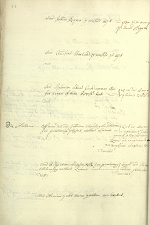Midwives and the Church, continued
There are several explanations for such a decision. The first is that while cost varied, getting a license could cost quite a bit of money, at least ₤1 and sometimes double that. By way of comparison, it would take a female servant six weeks to earn that much. In addition, a new midwife was required to travel to York to take her oath and receive her license, which would not have been much of a chore for Bridget Hodgson, but for poorer and more distant midwives, the cost of the journey could present as much of an obstacle as the fee itself. (That said, it appears to have been common practice for the Church to waive or reduce the fees, and they sent some licenses by mail.) Finally, it seems clear from the surviving evidence that women did not see licensed midwives as more capable than their unlicensed counterparts. Midwives survived on their reputations, not their official credentials. Given the tangible costs and the negligible benefits, the question we should ask is less why did so few midwives apply for a license, but why did any midwives get one?
 The short answer is that most midwives got a license to practice when they had to. In some cases, as in Bridget Hodgson’s, it might be on the occasion of a visitation. Diocesan officials often enquired whether there were any unlicensed midwives in the parish, and if the churchwardens said “Yes” the jig was up. (To be fair, most churchwardens allowed unlicensed midwives to practice unmolested.) It is also possible that a particularly conscientious clergyman could demand that midwives in “his” parish obtain licenses. This appears to have been the case for Anne Charlesworth and Sarah Butterworth, both from the parish of Almondbury, whose nominations coincided with the arrival of Thomas Tatham as the new vicar. More disturbing is the work of men such as John Elleray, who made a business out of hunting (and hounding) unlicensed midwives. After discovering one such woman, Elleray wrote to his masters in York, “I believe [she] is very short of money at present, but I shall call upon her frequently till she have got license.”
The short answer is that most midwives got a license to practice when they had to. In some cases, as in Bridget Hodgson’s, it might be on the occasion of a visitation. Diocesan officials often enquired whether there were any unlicensed midwives in the parish, and if the churchwardens said “Yes” the jig was up. (To be fair, most churchwardens allowed unlicensed midwives to practice unmolested.) It is also possible that a particularly conscientious clergyman could demand that midwives in “his” parish obtain licenses. This appears to have been the case for Anne Charlesworth and Sarah Butterworth, both from the parish of Almondbury, whose nominations coincided with the arrival of Thomas Tatham as the new vicar. More disturbing is the work of men such as John Elleray, who made a business out of hunting (and hounding) unlicensed midwives. After discovering one such woman, Elleray wrote to his masters in York, “I believe [she] is very short of money at present, but I shall call upon her frequently till she have got license.”
While this description of the rigors of the licensing process might give the impression that the relationship between midwives and the Church was largely antagonistic, this was not the case. Most unlicensed midwives were never cited at visitations, and it is unclear how widespread the activities of men such as John Elleray were. When midwives appeared before the Church Courts, they were far more likely to appear as witnesses than defendants, and as we shall see in the section on Midwives and the Law, the majority of midwives worked closely with local officials to detect and prosecute crimes ranging from witchcraft, to rape, to infanticide.